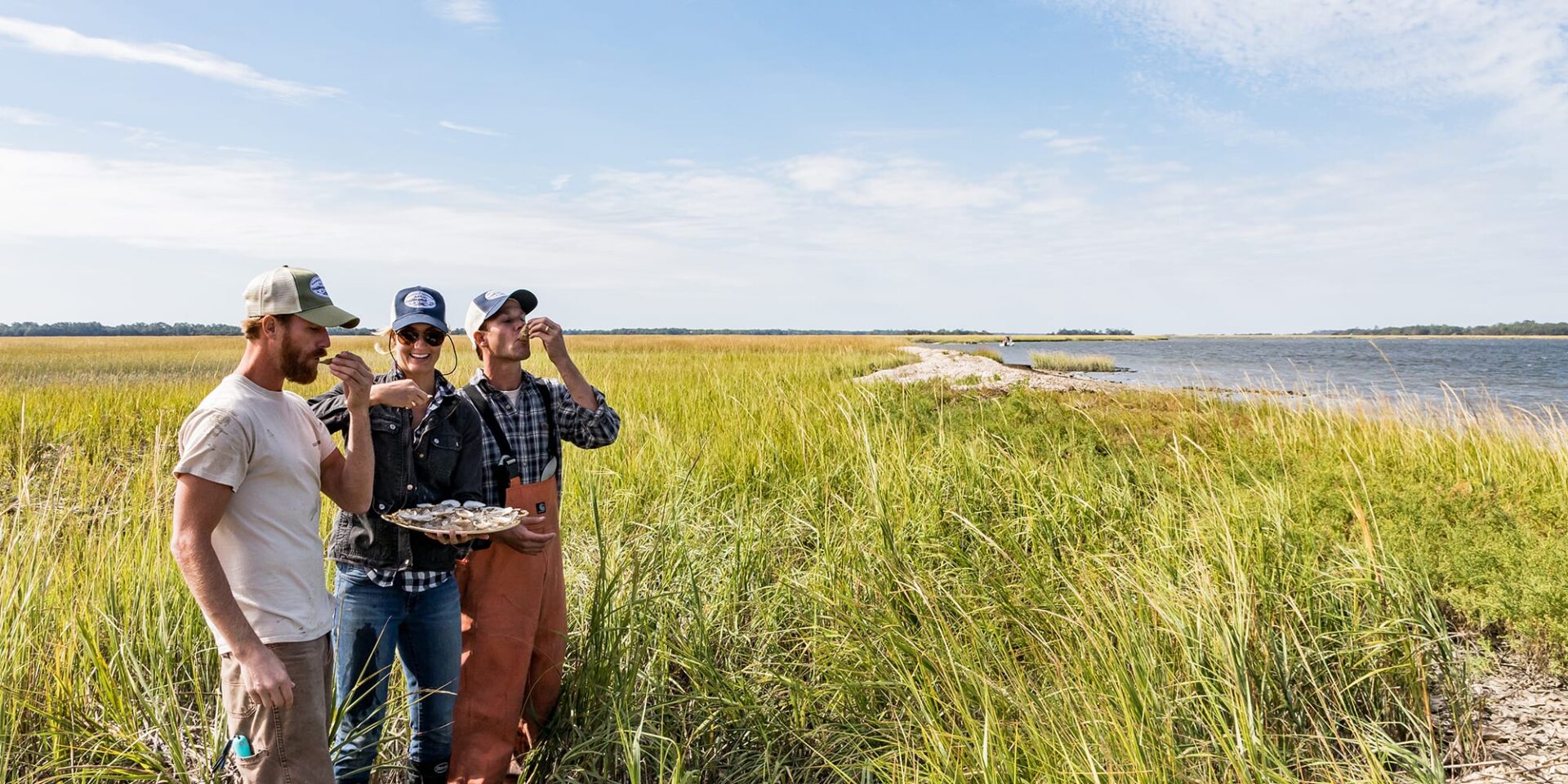The Lowcountry is on the verge of a mariculture boom. Meet some of the young salts who are part of the new wave
It’s early morning at the old Backman’s Seafood waterfront on rural Sol Legare Road, just seven miles as the crow flies from downtown Charleston, South Carolina. The rising sun pierces a grey cloud bank, illuminating a sweeping expanse of marsh. Back at the turnoff, the sign that once beckoned generations of locals to detour out this way for fresh shrimp, blue crabs, fish, and oyster clusters, is gone. In its place: a spanking new residential development, still under construction, an omen of creeping gentrification. When Thomas Backman, Jr. died three years ago, so did his family’s retail seafood operation, but the shop still stands, its white paint peeling on cement walls. Inside, the landline still rings for Backman. To many, this place is sacred—a stalwart remnant of one of Charleston’s last working waterfronts in a neighborhood originally settled by freed slaves in the late 1800s.
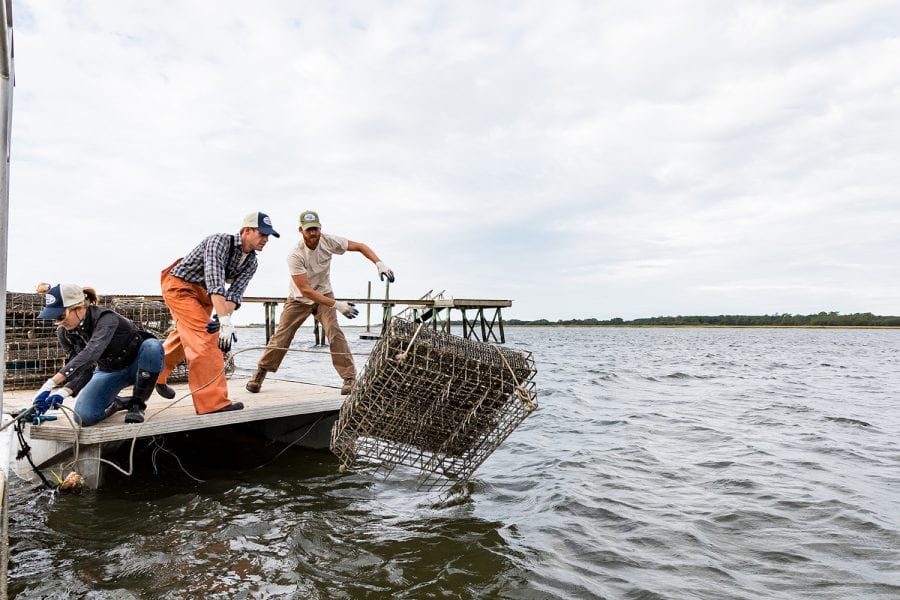
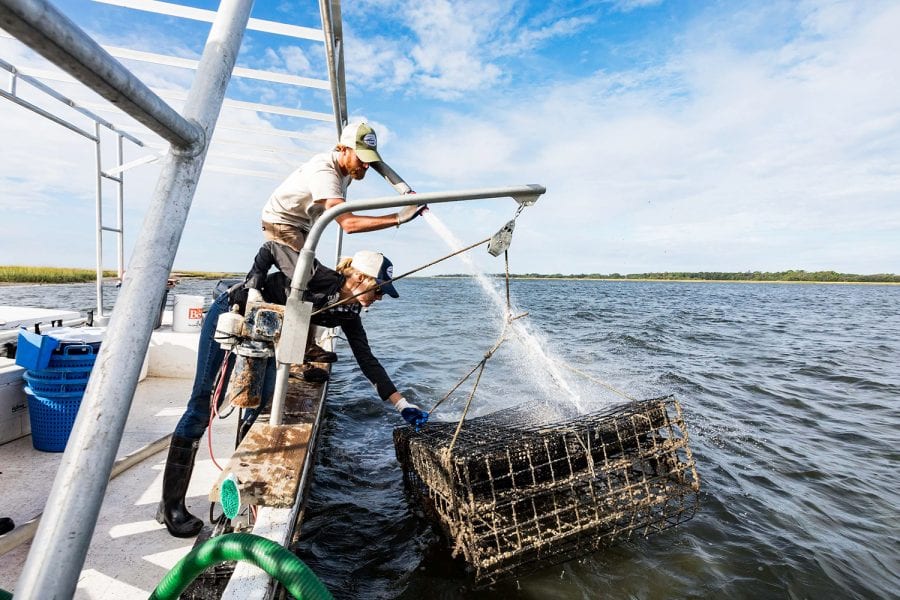
This morning, there are signs of activity. A boat trailer mounted with a 22-foot skiff parks next to the old store. Inside, by empty seafood display cases, light shines through newly washed red and white gingham curtains. Twins Thomas and Peter Bierce, along with Peter’s new bride, Caitlyn Mayer, comprise a company called Charleston Oyster Farm. Today they prepare for a morning on the water. With permission from the extended Backman family, the trio use the property as their base of operations. In nearby waters, they will be harvesting about two thousand oysters bound for Charleston restaurants such as the Darling, Pearlz, 167 Raw, and Chubby Fish (where they sometimes appear as “guest shuckers”), plus Kimball House in Atlanta. Charleston Oyster Farm is part of a growing surge of young oyster farmers intent on expanding South Carolina’s promising mariculture industry.
Mariculture, as opposed to wild harvesting, involves taking hatchery- born oyster seedlings the size of lentils, raising them in cages in tidal creeks where they fatten up naturally on the Lowcountry’s plentiful supply of phytoplankton, then marketing them as half-shell singles. While all other shellfish industries have seen steady decline, oyster mariculture is on the rise. Virginia’s $50-million oyster industry serves as aspirational model. South Carolina, whose aggregate tidal coastline approaches that of the Old Dominion state, stands poised to reap its own briny rewards.
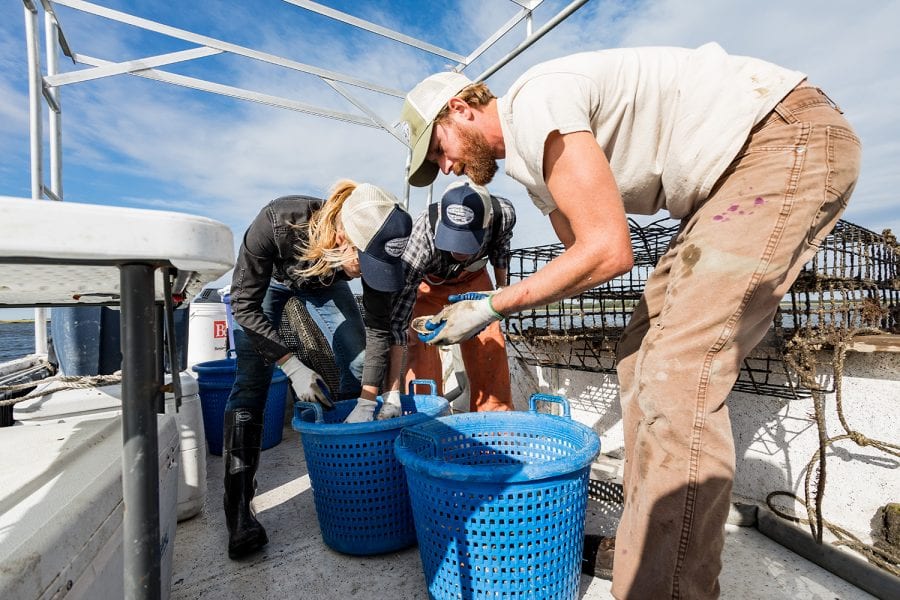
YOUNG SALTS
As a group, the Charleston Oyster Farm trio come well informed, with undergraduate majors in marine science, coastal geology, and environmental geoscience, plus Mayer’s graduate degree in environmental studies with a focus on water quality. Boiled down, this translates to three young individuals who care deeply about their coastline. How they landed in this spot on Sol Legare is a matter of fate.
Thomas Bierce befriended Captain Dave Backman in 2016 when an approaching hurricane literally blew him his way. In preparation for the storm, Backman sailed into the Folly River to help a friend lower masts. No good deed goes unpunished, and the transmission on his boat blew. Thomas Bierce, who was working in marine construction and boat repair, towed Dave back to the family waterfront at Sol Legare, where he met Sammy Backman. Friendships were forged. Months later, seeing that the dock was in desperate need of fortification, Thomas Bierce brought over a buddy’s barge to drive down new pilings. He even launched a GoFundMe campaign to enable the Backman family to restore their commercial waterfront after the crippling double whammy of Hurricane Matthew and a tornado that lifted an oyster cooler and dropped it a hundred feet away. But the campaign failed to gain traction. The property now sits in limbo as usage ideas are debated and developers salivate.
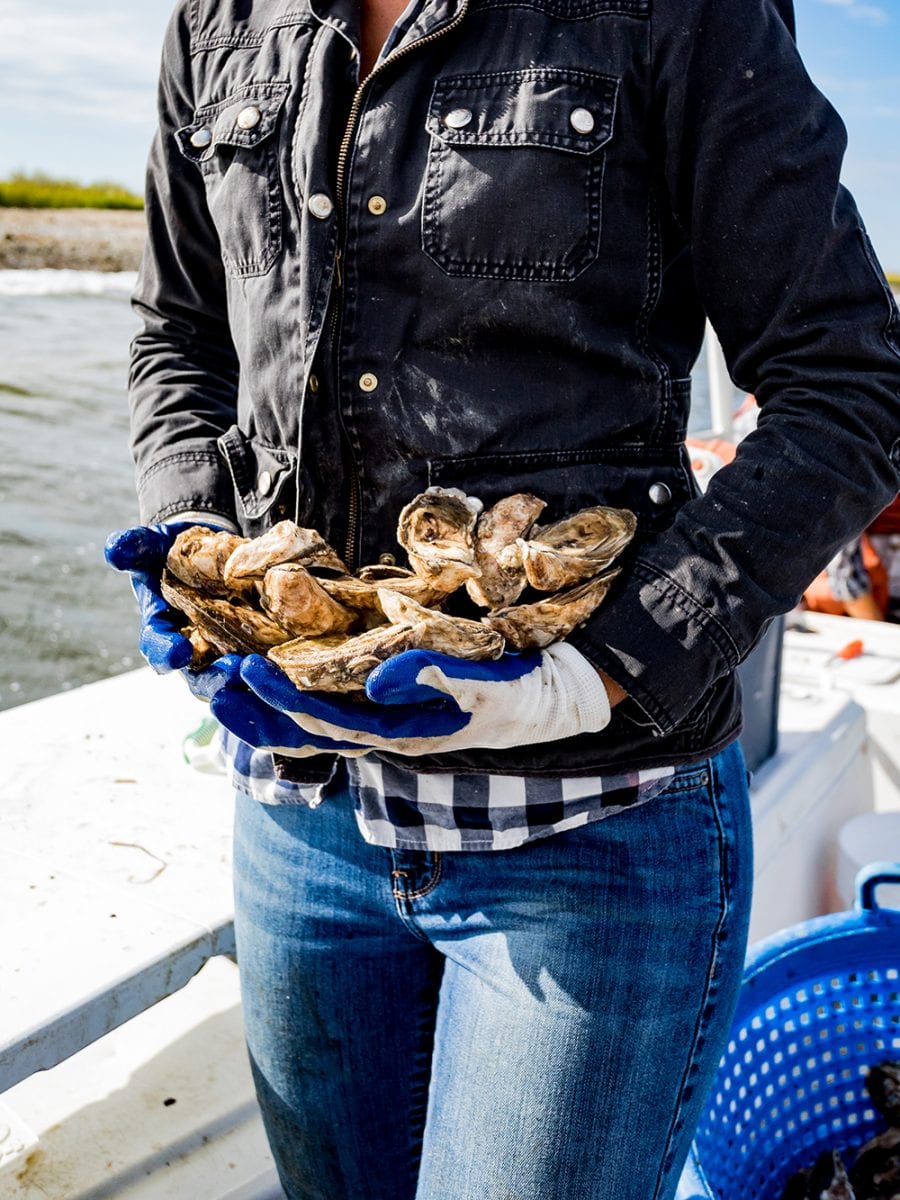
Charleston Oyster Farm, for now, is a grateful guest. “Locals used to fish off here all the time,” says Thomas Bierce. “It’s a pretty tight-knit community with multiple generations of families. Everybody looks out for each other. If we could grow the oyster industry and get some of the community involved, this place could be revitalized from a dying shrimping industry into something that benefits the local estuary and the fishing economy.”
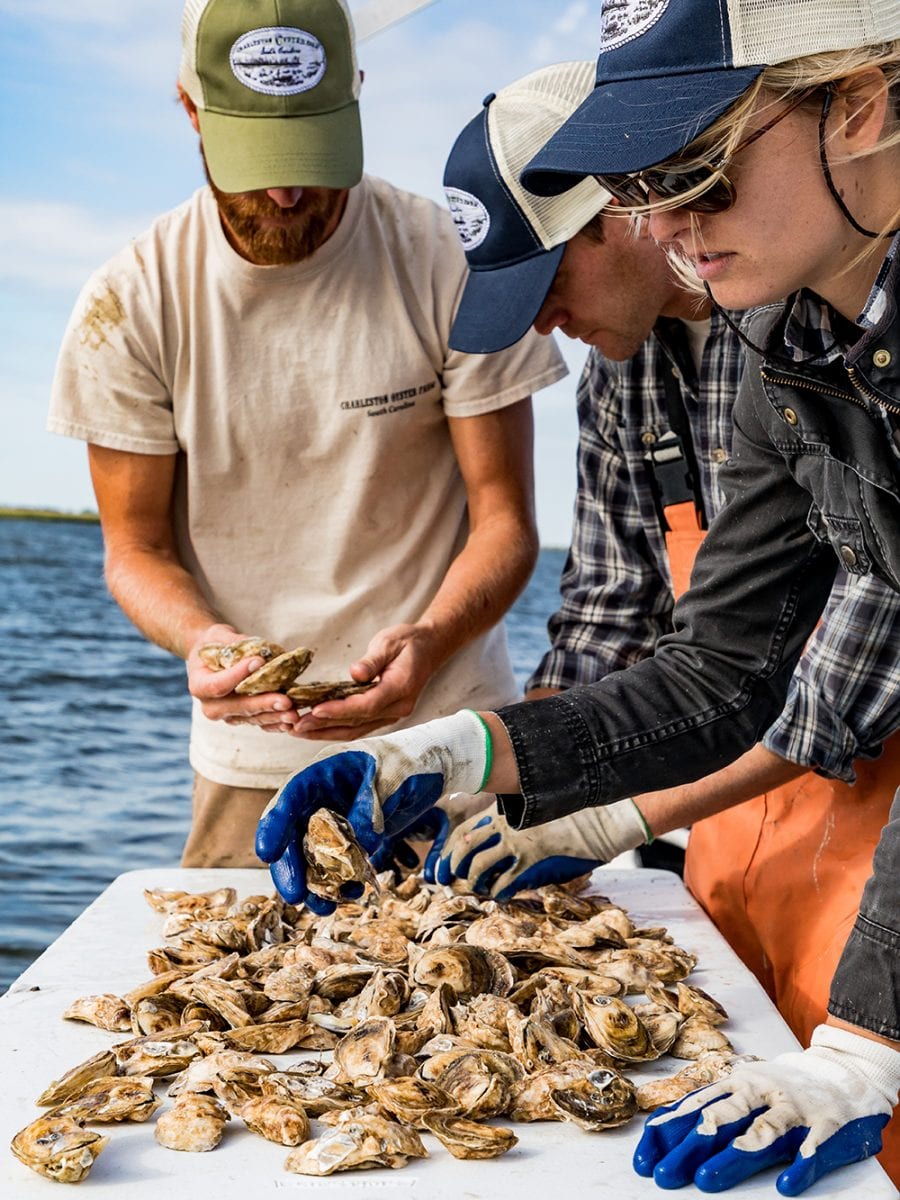
With gear and bushels of ice loaded up, the trio drive their boat trailer a mile down road and put in at the landing. Thomas Bierce pilots the skiff away from the dock and down the Stono River, past a flight of sunning cormorants. The commute is short. They pull up to an anchored pontoon platform loaded with air-drying cages that harness the sun’s rays to combat the growth of algae and barnacles. The twins hoist the cages back into the water at intervals, each connected by rope to buoys bobbing at the surface, much like lobster traps off the coast of Maine.
A FLEDGLING INDUSTRY
Oysters are nothing new to South Carolina, as evidenced by a nearly four- million-year-old local fossil in a collection at the Charleston Museum. Before Charleston was even Charlestown—the name of the original settlement across the Ashley River—seventeenth-century settlers nicknamed the peninsula “Oyster Point” for its piles of accumulated shellwash. What is new, however, is the approach of mariculture: The idea inspired early experimentation by a man named Truesdell who “planted” oysters in waters behind nearby Sullivan’s Island in the 1820s. He guarded them with a loaded blunderbuss before serving his prized selects in his downtown Charleston restaurant. The nineteenth century saw other such experiments by the McCradys and the Magwoods, but the twentieth century gave way to a booming oyster canning industry that eclipsed the singles market.
By the time chef Mike Lata moved to Charleston in 1998, there was no half-shell culture. “It didn’t exist,” says Lata. “That was strange to me. Nobody could sell me local half-shell singles.” The first to come forward was David “Clammer Dave” Belanger, who worked under Lata’s direction in 2007 to perfect a long, fluted wild single called Capers Blades. Then came Frank Roberts, an ex-Marine intent on raising oysters from seed in pristine estuaries near Beaufort. Roberts opened the state’s first hatchery and produced his popular Single Ladies, plus Phat Ladies exclusive to Lata’s fancy seafood hall, the Ordinary.
In 2015, New York Times op-ed columnist and former restaurant critic Frank Bruni visited Charleston and ordered a plate of East Coast oysters at the Ordinary. The line-up, sourced by Lata from Prince Edward Island to Maine to Massachusetts and all the way down the eastern seaboard to Seabrook Island, South Carolina, was designed to illustrate how the same species, the Eastern Oyster (Crassostrea virginica) mirrors the environment in which it is grown, with distinct variations in flavor, size, shape, salinity, and texture.
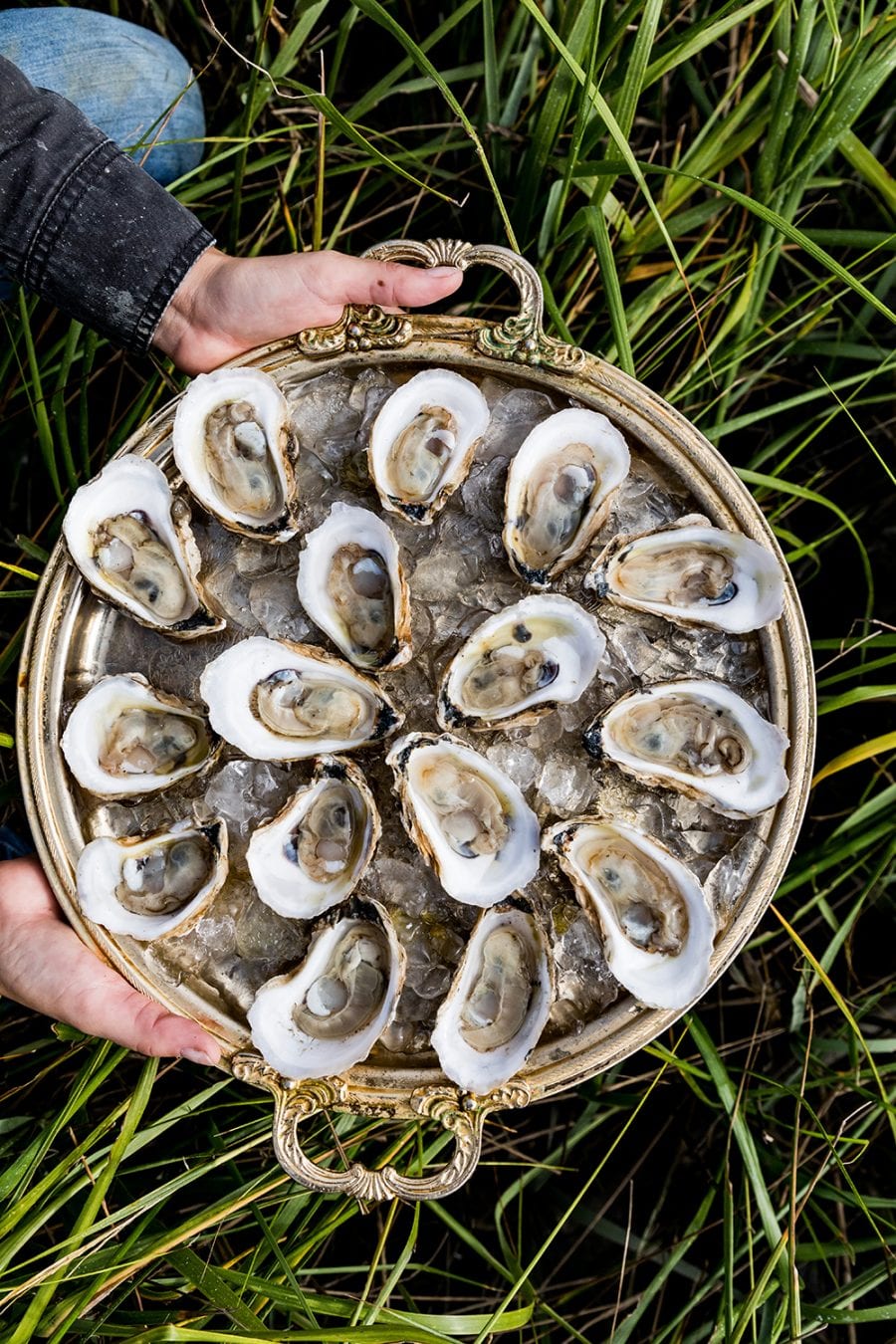
Bruni savored them one by one. That night, he sent the following message to his more than 300,000 Twitter followers: “If you go to the Ordinary, and they have Lady’s Island (SC) oysters, get a dozen. No, get three dozen. Really, really good.” The word was out. Roberts’ phone lit up with requests for out-of-state sales. But it was all he could do to keep up with in-state demand. He hoped that other like-minded growers would follow suit, and became such a vocal advocate for the industry that today many young growers call him “The Godfather.” There are currently seventeen oyster mariculture permits issued by South Carolina’s Department of Natural Resources through its Shellfish Management Program (some permits are held by the same company for different lease sites). In raw bars around town, you’ll now find Mosquito Fleet Petites, Perky Sea Cups, Toogoodoozies, Sea Clouds, and Lowcountry Cups, sourced from a handful of hardworking new growers, with still more on the horizon.
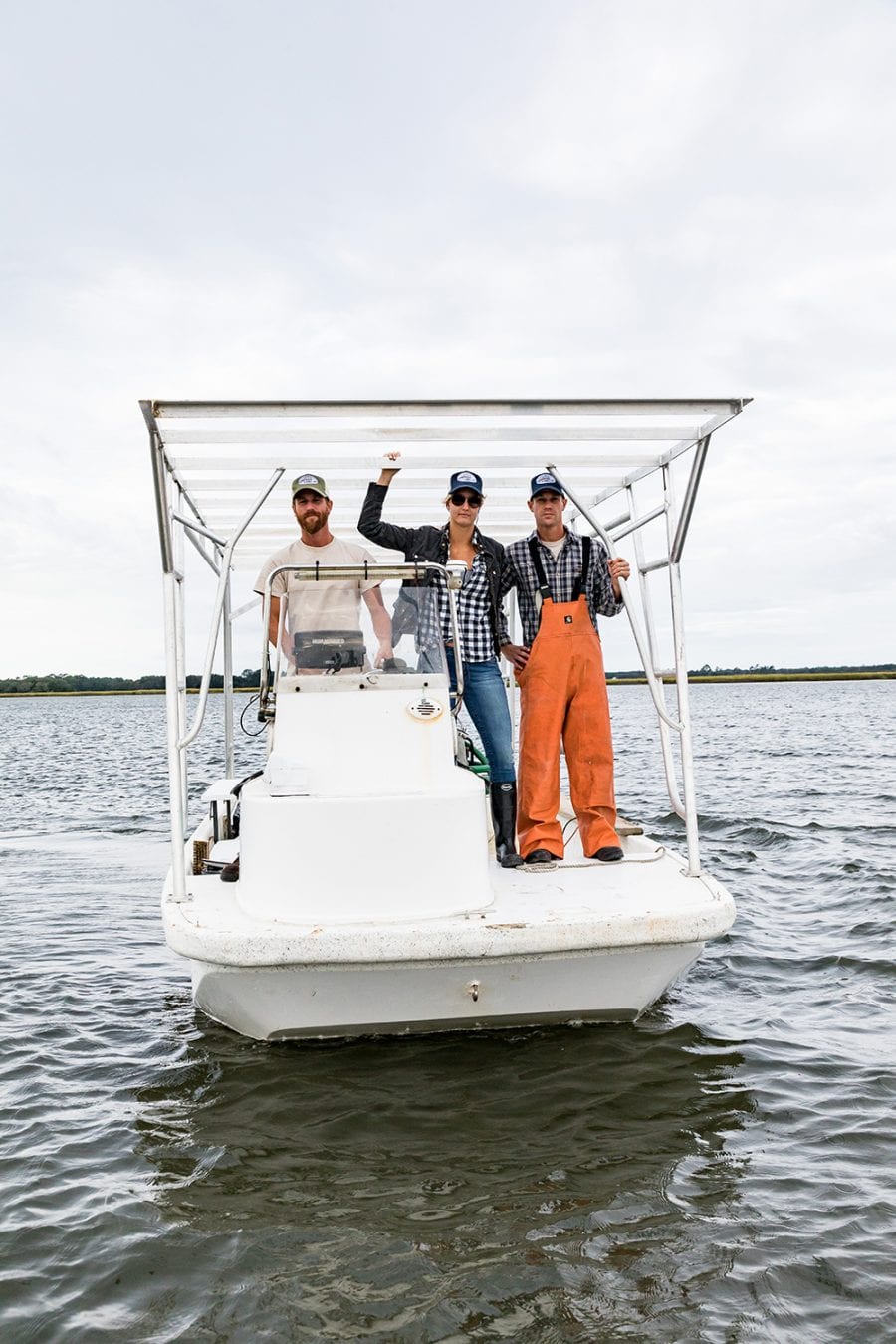
In an industry formerly dominated by old salts, there’s plenty of youthful enthusiasm to go around. About this time last year, Belanger told me, “In our recent meeting [of the South Carolina Shellfish Growers Association], the new guys just completely took over. Before, when we would elect officers, we would sit down at our one meeting per year because everybody was always too busy for all those damned meetings, and the voting would go like this: ‘You do it. No, you do it. No, I don’t want to do it. You do it.’ But this time, I was barely put on the board. I don’t mind because my ego is not wrapped up in it, just as long as I am there to point out the pitfalls.”
HARVEST TIME
This morning at Charleston Oyster Farm, waves lap against the shoreline’s bleached shellwash with a soft, tambourine-like jingle. The sky exceeds peripheral vision above the broad Stono River. The air is crisp, cuing spartina grass to turn gold. Soon, the grasses will go dormant for the winter, flooding the waterways with a tonnage of nutrients for the oysters. The water brims with potential.

Thomas Bierce steers the skiff over to a harvest spot where the oysters have sufficiently matured. Using a davit at boat’s edge, the twins haul up a large cage filled with rectangular baskets full of healthy bivalves. Peter Bierce taps the cage to give interlopers notice to vacate the premises. A small crab scurries from its hiding place amid the shells and plops into the water. Mayer cranks up a generator-powered hose that recycles onsite seawater to clean the oysters. A rainbow slices through the spray.
“Many other oyster farms take their oysters back to a facility on land where they clean them with fresh water,”says Mayer, “but it’s more environmentally friendly to do everything onsite so that all the by-catch in the cages,like crabs, fish, and shrimp, can stay in their habitat. Our goal is to operate in a way that keeps everything in theenvironment. We want to be good stewards, and show people that it’s really not that much harder to build a sustainable local industry.”
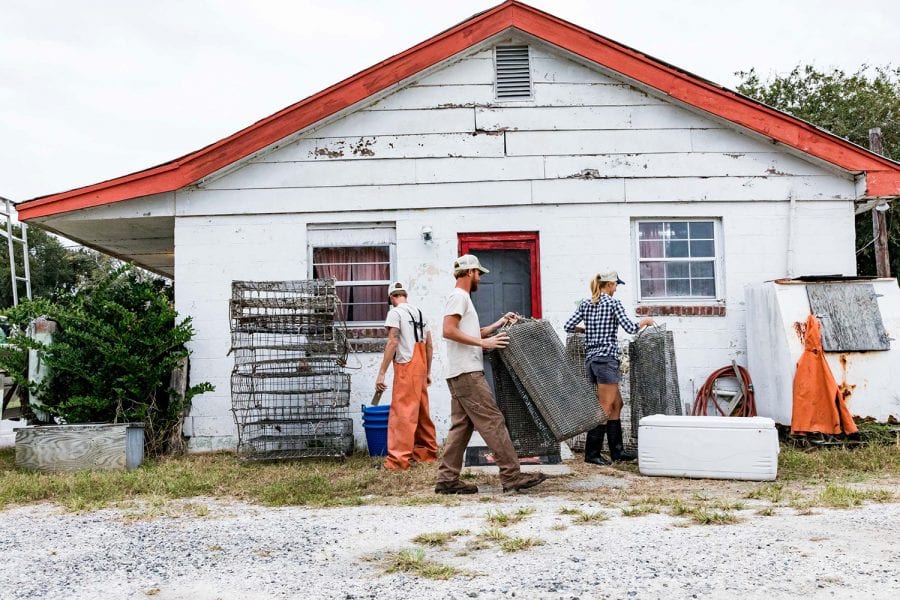
Oyster cages, much like wild reefs in nature, host scads of juvenile species that take refuge in the interstitial cavities between shells as they hide from larger predators. Oyster farms double as nurseries. And given that a single oyster can filter up to fifty gallons of water per day, keeping nature’s nitrogen levels in check, oysters farms “pay it forward” to benefit the ecosystem at large and the fisheries that depend upon it.
Oyster farms, by extension, promise a certain lucrative ripple effect. “One oyster farmer can bring in over a million dollars in revenue for the state,” notes Mayer. “I’m not talking about revenues for the farmer directly, but for paid labor, for oyster equipment retailers, restaurant profits, tourism, and our fisheries.” Peter Bierce carefully empties a basket of oysters onto the sorting table, where the trio swiftly inspects each one, tossing them into their allotted buckets. Smaller oysters will remain to continue growing. Medium oysters measuring between 2½ and 2¾ inches will be marketed as “Mosquito Fleet Petites,” a respectful nod to the local Gullah-Geechee fishing fleet in Charleston’s recent past. And the largest, exceeding three inches in length, will go to restaurants as “Perky Sea Cups.” (You can imagine the crew having a laugh when coming up with that name.)
“That’s a fatty!” says Thomas Bierce, holding up a gorgeous specimen with a rounded, deep cup and transparent fluting around its lip, an indication of new growth. He inserts the tip of an oyster knife near the hinge, gently pries open the shell, slips the knife beneath the meat to detach it, and slurps down his intensely salty reward. A drop of oyster liquor dribbles down his beard. His brother and Mayer follow suit, shucking oysters and sampling the fruits of their labor. There may be pitfalls, as Belanger pointed out, and indeed the trio have had more than their fair share of permitting delays—plus a runaway trawler that wrecked on their farm, shutting them down for six weeks—but on days like today, they are having a “world is our oyster” moment.
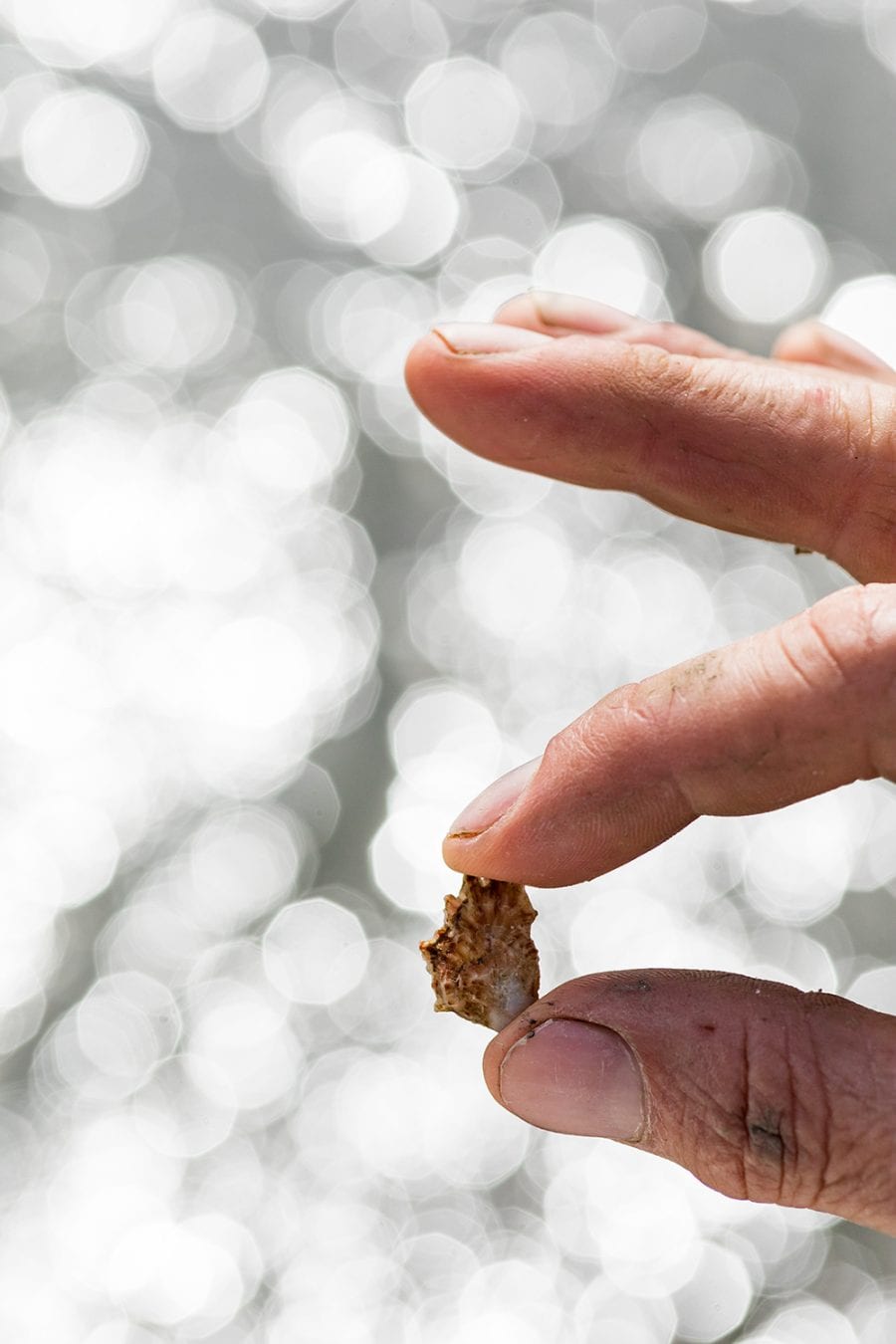

AN OYSTER IS BORN
“Birds do it, bees do it,” and, as Cole Porter crooned, “even oysters in Oyster Bay do it. Let’s do it, let’s fall in love.” But how exactly do oysters do it? Frank Roberts at Lady’s Island Oyster needed to answer that question in order to establish a hatchery. With the assistance and expertise of Julie Davis from the South Carolina Sea Grant Consortium, Roberts now has the carefully controlled process down pat.
- Roberts and Davis start with a few dozen healthy broodstock oysters. There’s no way to tell at first which are male and which are female. They’ll know soon enough.
- Each oyster is placed in a private tank on the “spawning table” with individual tanks connected by circulating water. Davis slowly raises the water temperature. Oysters get frisky when water warms above 65 degrees (in the wild, summer is the season of love).
- Davis watches them like a hawk. Not because oysters need chaperoning; because she will soon be able to tell male from female. The females open and close their shells, wafting millions of eggs into the water like a snow globe. Males shoot from the hip. Davis marks each tank with pink and blue tape.
- All the males and females are then pooled together in appropriate ratios. “That’s when we put on Barry White and turn the lights down,” jokes Roberts. Says Davis, “We pull everybody together and go have a beer.” Or two. That’s about how long it takes for fertilization to occur. Cells divide into microscopic popcorn kernels.
- Under a microscope, Davis analyzes the success and count, then divides them into tanks filled with filtered sea water. The water is changed every two days, and checked for predators. The larvae feast on phytoplankton, the naturally occurring ocean plant they love.
- After a few weeks, larvae are ready to settle down. They are moved to a tank with circulating water that mimics the downward pressure of a stream, propelling the larvae toward a bed of finely ground grains of oyster shell, each just large enough for a single larva to grab onto.
- “Once they have set, they are ready to eat us out of house and home,” Davis says. “They double in size in the first thirty-six hours.”
- The tiny oysters, called “spat,” are moved to outside tanks to grow for another month or so, then transferred to mesh bags to begin their life in the natural creeks and estuaries. As they grow, they graduate to larger baskets within floating cages.
- Lady’s Island Oyster sells the tiny seedlings to oyster farms up and down South Carolina’s coast, including Charleston Oyster Farm, plus farms in North Carolina and Florida. This year, Lady’s Island produced six million seeds and distributed them to sixteen farms. “By growing oysters this way, we are taking some pressure off the wild beds,” Roberts says.
- At Lady’s Island Oyster, native baby oysters are selectively bred not to reproduce, enabling them to grow twice as fast as wild ones. While wild oysters stunt their growth during the mating season by expending all their energy on reproduction, farmed oysters stay fat and happy. In South Carolina’s warm water, and free from sex-on-the-brain distractions, farmed oysters can reach maturity in as little as ten months, versus a wild oyster’s three years. That’s a business model hard to turn down.
share
trending content
-
Our Summer 2024 Issue is Here!
by Erin Byers Murray -
9 Noteworthy Kentucky Restaurants | Listen
by TLP Editors -
Crafting Excellence at Carrboro Coffee Roasters
by TLP's Partners -
Rasam is the Spice of Life
by Veronica Meewes -
The Best Southern Cookbooks of the Season | Listen
More From Roots
-
The Pakalachian Food Truck Blends Traditions | Listen
-
Treasuring Time at the Table at a’Verde
-
Remembering Malinda Russell through her Recipes
-
Ricky Moore’s Juneteenth Lunchboxes
-
Hamsa: All Roads Lead to Israel





